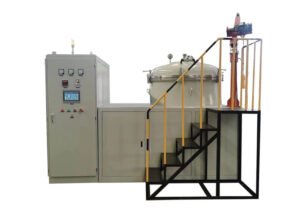Sintering is a key process in the production of cemented carbide and plays a decisive role in the final product’s performance. The sintering of cemented carbide can also be said to be the phenomenon or process that occurs when the sintered body is heated at an appropriate temperature and atmosphere. The sintering atmosphere is crucial to ensure the normal progress of the process and product quality. Therefore, it is necessary to understand the nature, function, influence, and control of the sintering atmosphere in the sintering furnace.
Except for the Hydrogen Atmosphere and Vacuum Atmosphere, there are below atmospheres in the cemented carbide sintering furnace:
Decomposition of ammonia
Decomposed ammonia is the decomposition of liquid ammonia, a mixed gas containing 75% H2 and 25% N2, with a low dew point of -40℃~-70℃ and free or residual ammonia below 0.05%. It can be used as a protective atmosphere for cemented carbide, and the price is low.
Due to the presence of N2, there will be a reaction:
TiC+1/2N2=TiN+C
TaC+1/2N2=TaN+C
Therefore, decomposed ammonia is unsuitable for sintering YT/YW alloys.
Nitrogen atmosphere in the sintering furnace
Nitrogen is produced by the decomposition of air condensed into a liquid state. High-purity N2 (99.9%) with a dew point close to -40°C. The nitrogen atmosphere is drier than decomposed ammonia, and its content (~5ppm) is lower than that of decomposed ammonia (10~35ppm). Decomposed ammonia also contains undecomposed (NH3) traces, which can cause alloy nitriding. However, pure nitrogen rarely produces nitriding.
It is feasible to replace part of H2 with N2 when there is no risk of nitriding and the production cycle does not depend on H2 in the atmosphere. Some companies used an atmosphere of 8-10% H2 and the rest N2 during sintering. In the United States, nitrogen atmosphere is often used in pre-burning, which can reduce production costs and increase safety.
Hot press protective atmosphere
Hot pressing is the combination of forming and sintering at the same time. The heat press mix does not add forming agents. Ordinary hot pressing generally does not pass protective gas and vacuum. During the hot pressing process, the oxygen in the mixture powder reacts with the carbon in the graphite mold to generate CO and become a protective atmosphere. In recent years, foreign countries have developed vacuum hot pressing and protective atmosphere hot pressing based on ordinary hot pressing.
The hot isostatic pressing protective atmosphere in the sinter HIP furnace
Hot isostatic pressing can be sintering under high-pressure protective gas and can also be regarded as a special hot pressing. It uses inert gas as protective gas (to protect the sheath or product from oxidation) and a pressure medium. Usually, argon is used, but helium is too expensive.










